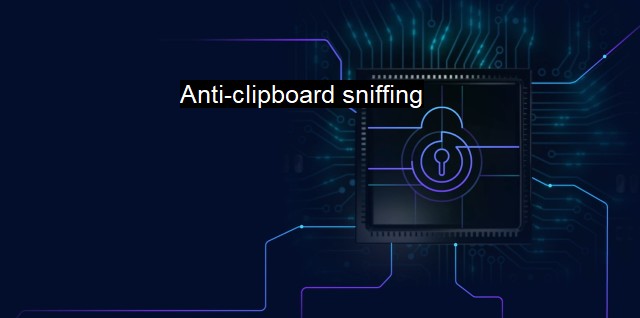What is Anti-clipboard sniffing?
Protecting Our Digital World: Combating Cybercriminals and Preventing Clipboard Sniffing
Anti-clipboard sniffing refers to measures taken to protect computer systems against a type of malware attack known as clipboard sniffing. Cybersecurity threats have grown significantly over time, and with our increasing dependence on digital platforms for daily activities, it is imperative to understand and counter such threats.In commonplace scenarios, a computer's clipboard is a temporary storage area that holds an item that has been cut or copied from a document or file, with the intention to paste it elsewhere. We typically use the clipboard, even unknowingly, while copying and pasting text, images, or links. While it seems quite simple and ubiquitous, your clipboard data may sometimes bear confidential and sensitive information such as passwords, credit card numbers, and private messages. This privacy concern becomes accentuated when cybercriminals target the clipboard to steal information; the corresponding cybersecurity threat is known as clipboard sniffing.
Clipboard sniffing refers to the process of using malicious software or scripts to secretly monitor and capture data that a user copies into their computer's clipboard. Hackers then get access to this information to exploit in unauthorized activities. Clipboard sniffing malware can prove especially damaging when dealing with cryptocurrency wallets. If a user copies a cryptocurrency wallet address for a transaction, the malware can replace it with the hacker's wallet address. When unaware of this, the user may complete a transaction directly to the hacker's wallet.
This is where the concept of anti-clipboard sniffing comes into play, as a mechanism to counter the cybersecurity threat of clipboard sniffing malware. Anti-clipboard sniffing encompasses a collection of security measures initiated by software or hardware to deter, prevent, or at best, detect clipboard sniffing activities.
Anti-clipping sniffing functionalities aim at securing your clipboard from both internal and external threats, implementing checks at software and hardware levels. At its very basic, anti-clipboard sniffing software checks periodic alterations to the clipboard content to find suspicious activities. It may alert the user, or block or quarantine the suspicious process. Also, some antivirus programs carry built-in anti-clipboard sniffing capabilities, which effectively monitor changes to the clipboard and guard it against such malware.
Some advanced systems may also include automated scanning facilities to analyze the processes and files associated with the clipboard or provide features to disable clipboard sharing over the network. Certain platforms propose end-to-end encryption of clipboard content to ensure that the text copied to the clipboard is inherently meaningless for an interceptor.
When it comes to anti-clipboard sniffing, it's not only about implementing the right tools and security measures but also adopting secure practices. Users are advised to not copy sensitive data to their clipboards or to clear their clipboards after they copy confidential information to it. Updating system software and browsers and using an antivirus with anti-clipboard sniffing technology are further recommended steps.
The degree to which an anti-clipboard sniffing solution can protect a system's clipboard depends primarily on the sophistication of its implementation. given the continuously evolving nature of cyber threats, it remains important to continuously update and adapt these counter-measures alongside increased user awareness of such cybersecurity threats.

Anti-clipboard sniffing FAQs
What is anti-clipboard sniffing and why do I need it?
Anti-clipboard sniffing is a cybersecurity technique that helps protect your sensitive information when you copy and paste it using the clipboard on your computer. Clipboard sniffing is a common tactic used by malware that can intercept and steal your sensitive data. By using anti-clipboard sniffing software, you can prevent this kind of attack and ensure that your information remains secure.How does anti-clipboard sniffing work?
Anti-clipboard sniffing works by monitoring the clipboard activity on your computer and preventing any unauthorized access to your sensitive information. This is achieved by encrypting the information on your clipboard and blocking any attempts to intercept or view it.Is anti-clipboard sniffing included in antivirus software?
While some antivirus software may include anti-clipboard sniffing features, it is not always the case. It's important to check the features of your antivirus software to see if it includes this type of protection. If not, you can look for separate anti-clipboard sniffing software that can be used in conjunction with your antivirus program.Is anti-clipboard sniffing necessary for everyday computer use?
While it's not necessary for everyday computer use, having anti-clipboard sniffing software can provide an additional layer of protection for your sensitive information. This is particularly important if you frequently handle confidential data, such as financial or personal information. It's always better to be safe than sorry when it comes to cybersecurity, so anti-clipboard sniffing can be a valuable tool to keep your information secure.| | A | | | B | | | C | | | D | | | E | | | F | | | G | | | H | | | I | | | J | | | K | | | L | | | M | |
| | N | | | O | | | P | | | Q | | | R | | | S | | | T | | | U | | | V | | | W | | | X | | | Y | | | Z | |
| | 1 | | | 2 | | | 3 | | | 4 | | | 7 | | | 8 | | |||||||